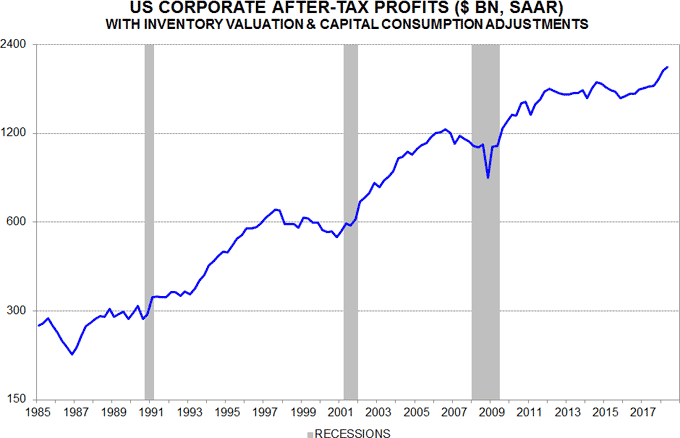Entries from September 2, 2018 - September 8, 2018
An example of the misuse of economic statistics
A colleague was sent the first chart below, which shows that US after-tax corporate profits peaked six quarters before the onset of the 2008-09 recession and 15 quarters before the 2000-01 recession. With profits reaching a new record in the second quarter of 2018, according to data released last week, the suggestion is that any recession is unlikely before late 2019 at the earliest.

Why does this chart represent a misuse of statistics? An immediate question is why it covers only two recessions. The second chart extends the sample period back to 1985 to encompass the 1990-91 recession. Profits peaked in the quarter immediately preceding the start of that recession. Allowing for a one-quarter reporting lag, there would have been no recession warning from a fall in profits.

The chart, moreover, uses the current vintage of profits data. Profits numbers are frequently revised heavily, making it important to check that real-time data showed a similar profile. The third chart adds real-time profits* as reported in the month immediately preceding the start of the 2008-09 and 2000-01 recessions (i.e. December 2007 and March 2001).

Unlike the current vintage data, real-time profits had not fallen when the 2008-09 recession began and had declined for only one quarter before the 2000-01 recession.
Contrary to the suggestion of the creator of the chart, the new high in profits reported for the second quarter offers no reassurance that a recession is distant.
*Source: St Louis Fed ALFRED database.
Monetary / leading indicator signals still negative
Near-complete July monetary data confirm an estimate in a previous post that six-month growth of real (i.e. inflation-adjusted) narrow money growth in the G7 economies and seven large emerging economies fell to its lowest level since February – see first chart. The “big picture” is that real money growth declined significantly between June 2017 and February 2018 and has since moved sideways, remaining below its range over September 2008-November 2017. Allowing for a typical nine-month lead, this suggests that six-month industrial output growth will fall further into late 2018 and stay weak into early 2019.

The OECD’s composite leading indicators continue to confirm the downbeat message from narrow money trends. The OECD is scheduled to release a July update of its indicators on 10 September but most of the component information is already available, allowing an independent calculation. The G7 indicator is estimated to have fallen further in July, with a decline signalling future below-trend GDP growth – second chart. Weakness remains broad-based geographically; the July data, in particular, should confirm that the US indicator is now in a downtrend – third chart.


There were notable falls in six-month real narrow money growth in July in the US, Euroland, Canada, Switzerland and Sweden – fourth and fifth charts. The UK bucked the trend but the recent recovery may not survive the unwise August rate hike. Australia remains at the bottom of the range among developed economies, suggesting downward pressure on interest rates. Also of interest is a sharp contraction in Hong Kong domestic-currency real M1 reflecting recent pressure on the currency peg – sixth chart.



It has been suggested that trends in broad money, unlikely narrow money, signal a “Goldilocks” scenario of moderate global economic growth with subdued inflation. Six-month growth of G7 plus E7 real broad money, however, also eased in July and is below its average in recent years – first chart. Broad money, in any case, has been an unreliable indicator – it did not signal the 2008-09 recession in advance and wrongly suggested a “double-dip” in 2010-11. Real broad money growth did pick-up in 2015-16 ahead of the 2016-17 economic “boomlet” but this partly reflected a slowdown in inflation, while narrow money accelerated much more impressively.
It is possible that broad money growth is being supported currently by an incipient rise in risk aversion in financial markets and an associated increase in the precautionary demand for money, which is more likely to be in broad form (i.e. time deposits, notice accounts, bank bonds etc.) – such an effect may also help to explain why broad money trends remained solid in the initial stages of the 2008-09 financial crisis and recession.
The July monetary data confirm that annual growth of G7 real narrow money moved further below 3% and has now also fallen by more than 3 percentage points over six months. The second of the equities-cash switching rules described in a previous post, therefore, remained in cash at end-August.
The first rule is based on the difference between G7 plus E7 six-month real narrow money growth and industrial output growth, which remained positive in June – the latest available month of full industrial output data. Accordingly, this rule stayed in equities at end-August. Partial data for July, however, suggest that output growth recovered slightly; with real narrow money growth falling, the gap between the two may have closed, in which case the first rule would switch to cash at end-September.

